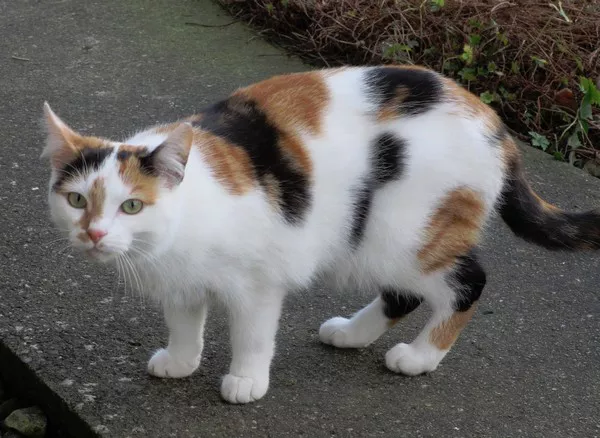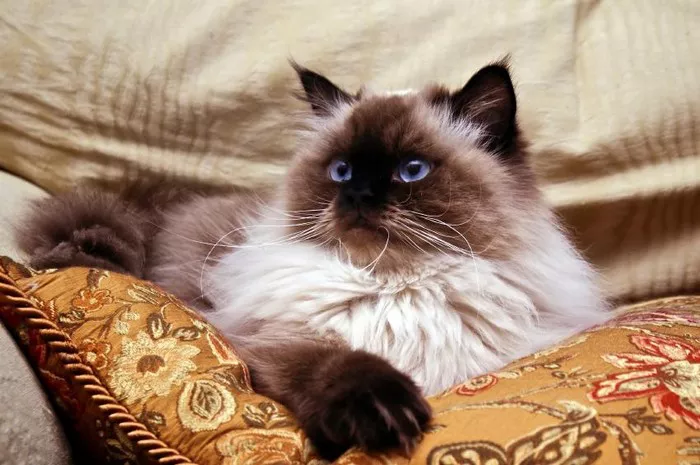Calico cats, with their striking tri-colored coats, are adored for their unique and vibrant appearance. Cat owners often wonder when their calico kittens will develop a fluffy coat, anticipating the soft and plush fur that can make these cats even more appealing. Understanding when and how a calico cat’s coat becomes fluffy involves looking at genetics, breed influences, growth stages, and overall health. This comprehensive article delves into these factors, providing insights and tips for ensuring your calico cat develops a healthy and fluffy coat.
Understanding Calico Cats
Before exploring coat development, it’s important to understand what makes a calico cat unique.
Genetics of Calico Cats
Calico cats are distinguished by their tri-colored coats, typically featuring patches of white, black, and orange. This coloring is due to a genetic phenomenon linked to the X chromosome. Since females have two X chromosomes (XX) and males have one X and one Y chromosome (XY), nearly all calico cats are female. The rare male calico is usually sterile and results from a genetic anomaly.
Breed Considerations
The term “calico” refers to a color pattern rather than a specific breed. Therefore, calico cats can belong to various breeds, each with different coat types and textures. Breeds that commonly feature the calico pattern include the American Shorthair, Persian, Maine Coon, and Japanese Bobtail. The breed significantly influences when and how a calico cat’s coat will become fluffy.
Stages of Coat Development in Cats
A cat’s coat undergoes several stages of development from kittenhood to adulthood. Understanding these stages helps set realistic expectations for when a calico cat will develop a fluffy coat.
Kitten Stage (0-6 Months)
During the first six months of life, kittens have soft, short, and fine fur, often referred to as their “baby coat.” This fur provides warmth and protection but is not typically fluffy. Around 3-4 months, you may start noticing subtle changes in the texture and length of the fur, but significant fluffiness is unlikely during this early stage.
Adolescent Stage (6-18 Months)
As kittens transition into adolescence, their coats start to change. By the time they are around six months old, their “adult coat” begins to develop. This period is crucial for determining the final texture and length of their fur. For long-haired breeds, this is when you might start to see fluffier fur appearing, though it may take up to a year or more for the coat to reach its full potential.
Adult Stage (18 Months and Beyond)
Most cats reach full maturity between 1.5 to 2 years of age. By this time, the coat should be fully developed. For breeds prone to fluffiness, this is when the fur will be at its densest and most luxuriant. Maintenance through grooming becomes important to keep the coat healthy and fluffy.
Factors Influencing Coat Fluffiness
Several factors influence when and how fluffy a calico cat’s coat will become. Understanding these can help cat owners take proactive steps to ensure optimal coat development.
Breed Genetics
The primary factor influencing coat fluffiness is the cat’s breed. Long-haired breeds such as Persians and Maine Coons naturally develop fluffy coats, often within the first year to 18 months of life. Short-haired breeds, like the American Shorthair, typically do not develop a fluffy coat, though they can have dense, plush fur.
Nutrition and Diet
A well-balanced diet rich in essential nutrients supports healthy skin and coat development. Proteins, omega-3 and omega-6 fatty acids, vitamins, and minerals play a crucial role in fur growth and maintenance. Feeding your calico cat high-quality cat food formulated for their life stage ensures they receive the necessary nutrients for a healthy, fluffy coat.
Health and Well-being
Overall health significantly affects a cat’s coat. Conditions such as allergies, parasites, and hormonal imbalances can impact fur quality. Regular veterinary check-ups, preventive care, and timely treatment of health issues are essential for maintaining a healthy coat.
Grooming and Care
Regular grooming helps maintain and enhance the fluffiness of a cat’s coat. Brushing removes loose fur, distributes natural oils, and prevents matting. For long-haired calico cats, daily grooming may be necessary, while short-haired cats benefit from weekly brushing. Bathing, while not frequently required, can also help maintain coat health if done correctly.
Environmental Factors
Environmental conditions, such as temperature and humidity, can influence a cat’s coat. Cats in cooler climates may develop thicker, fluffier coats as a natural response to the cold. Additionally, indoor cats with controlled environments may have less variation in coat density compared to outdoor cats exposed to seasonal changes.
When to Expect Fluffiness in Different Breeds
Since calico cats can belong to various breeds, the timeline for developing a fluffy coat varies. Here’s a closer look at when to expect fluffiness in some common calico breeds:
Persian Calico Cats
Persians are known for their long, luxurious fur. Persian calico kittens usually start showing signs of fluffiness around six months, with full coat development by 18 months to two years. Regular grooming is essential to manage their thick, flowing fur.
Maine Coon Calico Cats
Maine Coons are another long-haired breed known for their impressive fur. Calico Maine Coon kittens may start developing fluffiness around six to eight months, with full coat maturity by two to three years. Their coats are dense and water-resistant, requiring consistent grooming.
American Shorthair Calico Cats
American Shorthairs have short, dense coats that do not typically become fluffy. However, their fur can be plush and well-maintained with proper care. Coat changes in American Shorthairs are less dramatic, with adult fur fully developed by one year.
Japanese Bobtail Calico Cats
Japanese Bobtails have medium-length coats that can develop a slight fluffiness. These cats may start showing coat changes around six months, with full development by 18 months. Their fur is soft and requires moderate grooming.
Maintaining a Fluffy Coat
Ensuring that your calico cat’s coat remains fluffy and healthy requires ongoing care and attention. Here are some tips for maintaining a fluffy coat:
Regular Grooming
Regular brushing helps remove loose fur, prevent tangles, and distribute natural oils. Use appropriate grooming tools for your cat’s fur length and texture. Long-haired cats may need daily grooming, while short-haired cats benefit from weekly brushing.
Balanced Nutrition
Provide a diet rich in high-quality proteins, essential fatty acids, vitamins, and minerals. Consider supplements like fish oil to support skin and coat health. Consult your veterinarian for dietary recommendations tailored to your cat’s needs.
Hydration
Proper hydration is vital for skin and coat health. Ensure your cat has access to fresh water at all times. Wet cat food can also contribute to hydration.
Regular Veterinary Check-ups
Regular veterinary visits help identify and address health issues that could impact coat quality. Preventive care, including flea and tick control, is essential for maintaining a healthy coat.
Environmental Control
Maintain a comfortable indoor environment with consistent temperature and humidity levels. Avoid exposing your cat to extreme weather conditions that could affect their coat.
Bathing and Hygiene
While cats are generally good at grooming themselves, occasional baths can help maintain coat cleanliness. Use cat-specific shampoos and conditioners to avoid skin irritation. Ensure thorough drying to prevent matting and skin issues.
Common Issues Affecting Coat Development
Several common issues can affect coat development and fluffiness in calico cats. Recognizing and addressing these issues is crucial for maintaining a healthy coat.
Parasites
Parasites like fleas, ticks, and mites can cause itching, irritation, and hair loss. Regular preventive treatments and prompt veterinary care are essential to keep your cat parasite-free.
Allergies
Allergies to food, environmental factors, or grooming products can lead to skin irritation and poor coat quality. Identifying and managing allergens with the help of your veterinarian can improve coat health.
Hormonal Imbalances
Hormonal issues, such as thyroid disorders, can affect fur growth and texture. Regular veterinary check-ups and appropriate treatments are necessary to manage hormonal imbalances.
Nutritional Deficiencies
Inadequate nutrition can result in a dull, thin coat. Ensure your cat receives a balanced diet with all necessary nutrients to support optimal fur growth.
Stress
Stress can impact overall health, including coat condition. Provide a stable and enriching environment for your cat to reduce stress levels. Interactive toys, regular playtime, and comfortable resting areas can help.
Genetic Factors
Certain genetic conditions can affect coat development. If your cat’s coat does not develop as expected, consult your veterinarian to rule out underlying genetic issues.
Conclusion
When it comes to calico cats and their coat development, understanding the various factors that influence fluffiness is key. While the breed plays a significant role, individual genetics, nutrition, health, grooming, and environmental conditions all contribute to the final outcome. By providing proper care, balanced nutrition, and regular grooming, you can support your calico cat’s journey to developing a healthy, fluffy coat. Remember that each cat is unique, and patience and attentiveness are essential in helping your calico cat achieve its full coat potential. Whether your calico cat sports a short, dense coat or a long, luxurious one, their beauty and charm are undeniable, making them cherished companions for any cat lover.























